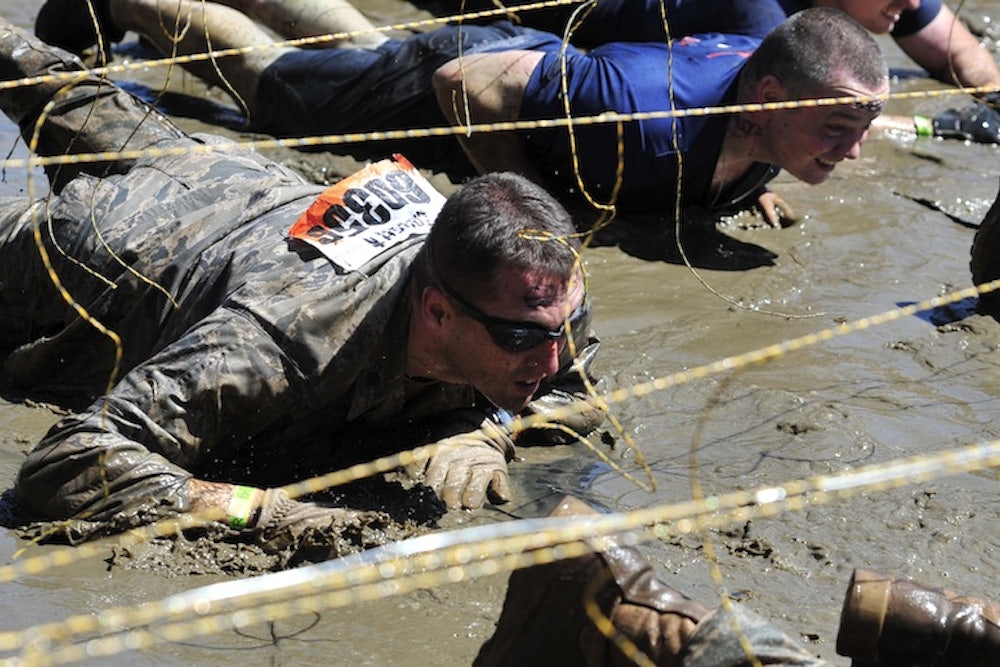As Heather Havrilesky argues in The New York Times, some of the trendiest fitness regimes seem more like preparation for the apocalypse than for the beach. Extreme physical challenges—like CrossFit, ToughMudder and Spartan Races—are more popular than ever before. Moreover, and the limits of what’s considered “extreme” are constantly being extended as we break new barriers in technology and technique. Not so long ago, the idea of running a marathon recreationally would have been preposterous.Last year, over half a million people finished one in the U.S. alone. Almost two million completed a half.
In a new book, Extreme: Why Some People Thrive at the Limits, psychologists Emma Barrett and Paul Martin analyze stories and characters past and present to shed light on why some people are drawn to dangerous, even life-threatening challenges like spelunking (cave exploration), BASE jumping (parachuting off a cliff), skydiving, or polar exploration.
Alice Robb: What motivates people to undertake extreme challenges?
Emma Barrett: Most people are motivated by more than one thing. Some of the more common include the desire to master skills and achieve high levels of performance, challenging the limits of their ability, as a social experience and as escape from personal problems or everyday tedium.
Another common motive is scientific curiosity: New discoveries are often made in the world's hard places. To understand how life might have existed in historic conditions on Mars, geologist Nathalie Cabrol explores analogues on Earth: high-altitude volcanic lakes in the Andes. As well as scientific prowess, she needs exceptional diving skills; she holds a world record for high-altitude free-diving.
AR: Is there a certain personality type that is drawn to this kind of challenge?
EB: There's a popular stereotype that people who engage in extreme activities do it for thrills. That's certainly true for some people. Commander Lionel “Buster” Crabb, for example, was a famous British military diver who was decorated for repeated acts of extreme bravery during World War II. According to one biographer, Crabb was a chain-smoking heavy drinker, with a passion for gambling and women, and a sexual fetish for rubber.
Secret solo (rubber-suited) missions might have suited Crabb. But other types of extreme environment would have driven him to distraction. In polar exploration, for example, progress is slow, there are extended periods of monotony and sensory deprivation, and explorers share the long dull hours with a small number of other people. Most thrill-seekers would find such conditions intolerable.
AR: What are the biggest challenges people face in these situations?
EB: Life-threatening physical challenges include hostile climates with extremes of temperature, a lack of breathable gases, and unusual physical forces like microgravity, and low or high pressure. Injury and death can occur in many different ways, including by freezing, overheating, drowning, suffocating, starving, dehydrating, falling, being crushed, falling victim to disease or to animal attack.
Yet many people argue that the psychological pressures are every bit as difficult to manage. People have to overcome fear and anxiety. Then there’s bad sleep, which impairs your ability to think clearly, take decisions, remember things and judge risk, and it has a corrosive effect on your relationships with other people.
Extreme environments often involve long periods of monotony, which many people find intolerable. Some people go into extreme environments for long periods alone, and must cope with loneliness and potential psychological breakdown.
Those who are isolated in an extreme environment with a small group other people and little opportunity for privacy risk becoming involved in damaging interpersonal conflict. In such circumstances, people can quickly fall out over seemingly trivial issues.
AR: How do people cope?
EB: Although we didn’t find evidence for an “extreme personality,” people who cope successfully in extreme environments do share some behavioral characteristics. For instance, they value expertise and experience, which means they put huge effort into training and preparing for extremes. They are able to endure hardships like hunger and thirst, dirt and squalor, pain and discomfort because they are highly motivated and able to focus on getting things done. In team endeavors, they work effectively by pulling their weight, making an effort to be tolerant of others, and being tolerable themselves. And, of course, they all show bravery by overcoming fear.
AR: Are there lessons the rest of us can apply—when our lives aren’t in danger?
EB: An important lesson we took from our research is that many things are better for us than we think they are, and should be valued more than they are. For instance, most people underestimate the harm caused by sleep deprivation, and people often regard solitude as a potentially dangerous state, although most of us derive benefit from periods of solitude. Even stress, discomfort, danger, and trauma—things that most people view as overwhelmingly bad—can have a positive side. Tough situations can build our resilience, strengthen our ability to cope under pressure, and make it more likely we’ll bounce back from future adversity.
People who venture into extreme environments are using the same set of skills as the rest of us—albeit more keenly developed—to deal with difficulties that are often just more extreme versions of difficulties we face in everyday life. This means that the lessons from extreme places are applicable to all of us.
This interview has been edited and condensed.
